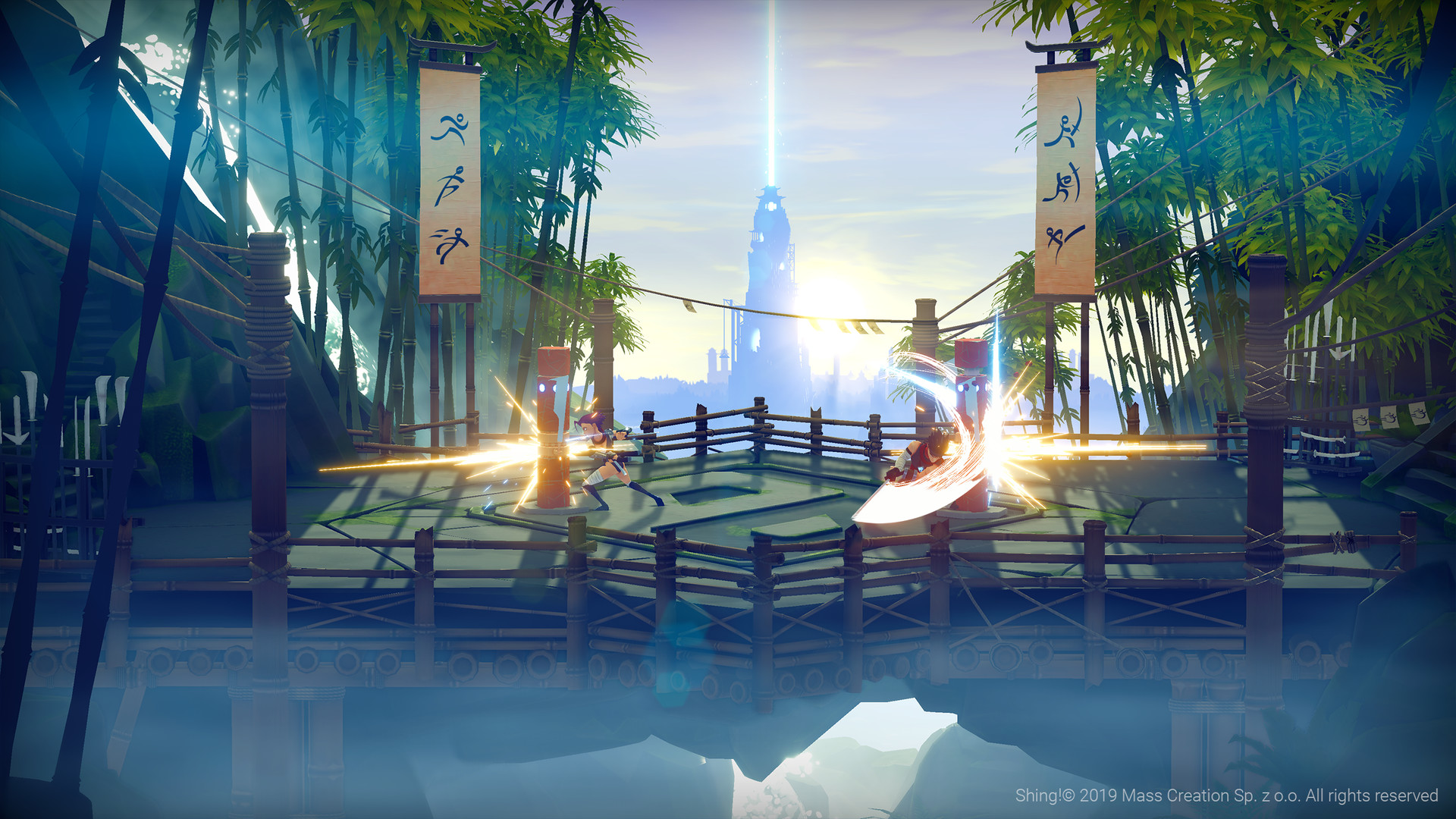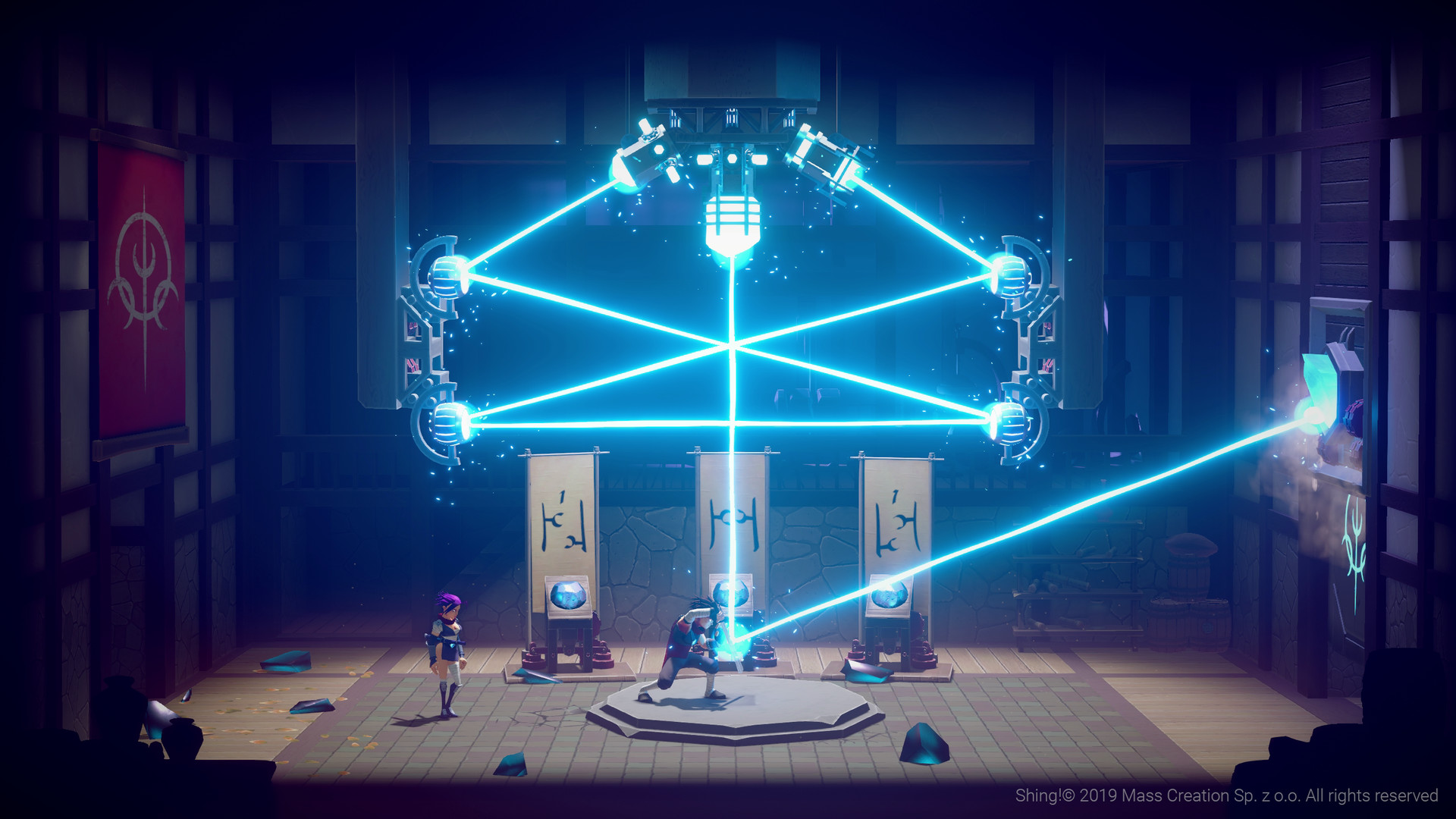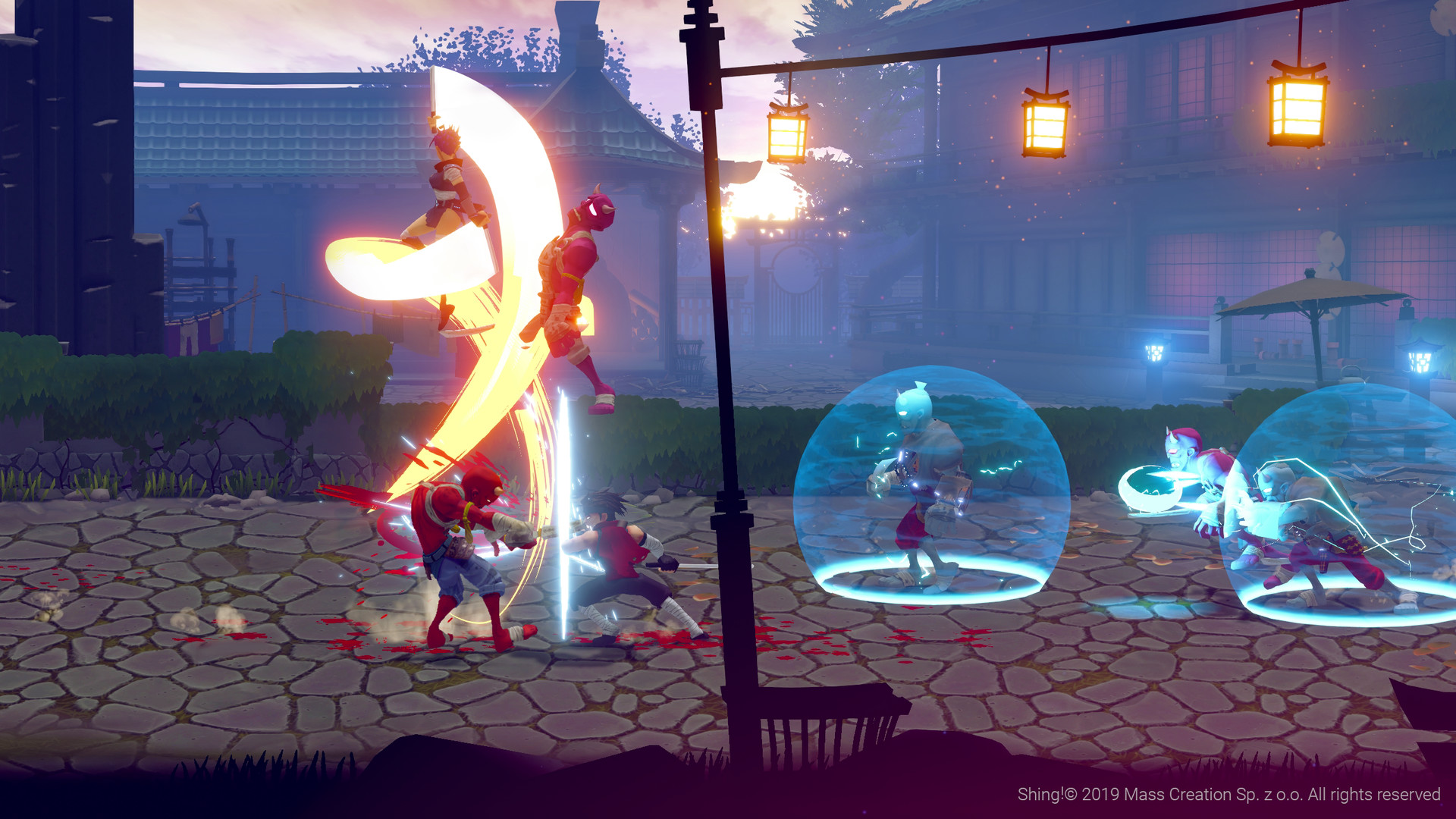
There’s nothing quite like a good beat ’em up, an with Shing!, it looks like developers Mass Creation are on track to deliver just that. Weapon variety, wacky combat arenas, bloody combat, and mastering the skills of a ninja, all rolled into one package? If done right, that can be a quintessential beat ’em up package for sure. We recently sent across some of our most burning questions about Shing! to the development team at Mass Creation, hoping to get more details on the upcoming game. The questions below were answered by game director Grzegorz Kurek and game designer Andrzej Sugier.
"Smart, interesting enemies that are fun to fight are one of the main ways we combat traditionally shallow beat’em’up gameplay. Each enemy in Shing! is distinct, with different behaviors, abilities and weaknesses."
Can you talk about the weapons in the game and what they have to offer in terms of variety?
When killed, each enemy in Shing! drops an orb that when picked up, grants you a specific, temporary ability. Your weapons might light on fire, you might start dropping bombs when dodging, and so on. Those abilities, in addition to making you stronger, can be used to exploit specific enemy weakness. For example: there’s an enemy that’s protected by an impenetrable shield. You have to break it by deflecting his projectiles back at him, which takes time and carries some risk.
But, if you picked up a thunder orb, and gained an ability to shoot lightning – you can use it to quickly break this shield! This allows you to plan each fight according to what enemies are present, which ability orbs they drop on death, and how can you use those abilities to exploit other enemies weaknesses. You can even save them between fights, and prepare for hard encounter ahead if you know what’s coming. This makes a skilled, knowledgeable player much, much more deadly, able to quickly dismantle each fight like a deadly puzzle.
Similarly, what can players expect from the game in terms of enemy variety?
Smart, interesting enemies that are fun to fight are one of the main ways we combat traditionally shallow beat’em’up gameplay. Each enemy in Shing! is distinct, with different behaviors, abilities and weaknesses. Each one has a specific role to play in combat – some might dash at you and try to keep you in place with a barrage of fast attacks, other might stay back and shoot you out of the sky if you try aerial combat, or force a one-on-one duel to test your skill with a blade.
They are not your typical punching bags – they are aggressive, flexible and relentless. To balance this increased complexity, player options are similarly expanded – you can dodge, block, parry and deflect enemy attacks, take the fight to the air or turn enemy abilities against them by smart positioning.
Shing! supports both local and co-op play, but as the ones making the game, would you say one of those two is the best way to experience the game?
We’re putting a lot of effort into making Shing! fun for both solo and co-op players, as we see both as legitimate ways to enjoy the game. We try to evolve the gameplay to accommodate for different amount of players, instead of simply spawning more enemies or increasing their health. One example of such balancing mechanic is the character switching – whether you play solo or in a team, you can always switch between 4 characters, each with their own health pool and collected ability buffs. This opens up a lot of tactical options for solo players or smaller teams, and keeps the amount of available health the same for all team sizes.
On the other side of the spectrum, when played with a full group of 4 players,many beat’em’ups become much too chaotic – as the simplest way to provide a suitable challenge for bigger groups is to provide them with more enemies to fight. But this is a design trap, as human brain can track only so many moving objects at once, and the game changes to an incoherent visual mess. This is why enemies in Shing! were designed to be able to deal with groups – many of them are just as dangerous whenever you face them alone or in a four-player team, some of them even specialize in crowd control. Thanks to that, we can keep the number of characters on the screen manageable, and make sure that the gameplay is challenging without making the action unreadable.
"Our feudal-era city is filled with neon signs and weird machines, or the ancient ruins are covered with living crystals and fractal coral. We always try to give players just a bit more eye-candy, make the world a bit more interesting, create a place that’s fun to be in."
How much do the different characters vary from each other in terms of play styles and abilities?
Outside visible differences in their animations and slight differences in terms of attack speed, power and range, each feel very different to control. That’s because of how our analog stick combat works – as each of your analog stick gestures translate into a single specific attack, even slight changes in the way your character responds have a huge impact on how you feel while controlling him or her. It’s something you don’t see on a video, but has a drastic impact on game feel. So even though their move sets are very similar, some characters feel lumbering and powerful, other swift and nimble or snappy and energetic.
Different attacks as well as different characters combined together can potentially pave the way for a lot of possible combos during combat – is that something the game places much of a focus on as well?
It’s something that gets much more prominent when you try to unlock skins or compete on leaderboards by mastering specific levels. One of the requirements to master a level is to beat it with a high enough Style score. To increase your Style, you have to vary your attacks, explore the full extend of your moveset, and, simply speaking, do cool shit. It goes up if you and your friend keep an enemy in the air for ages. It goes up if you slash five enemies to pieces with a single well timed parry attack. It goes up if you deflect an exploding enemy into a crowd of goons and then catch one of them in a mid-air combo before he touches the ground. We want to encourage players to experiment, be daring and push their limits, to feel like a kickass demon-slaying ninja who laughs in the face of danger.
From what we’ve seen of Shing! so far, it looks like it’s embracing its fantasy-leaning setting. How does that help you as developers in terms of being able to flex your creative muscles?
Well, for us it means we can fully embrace the rule of cool. Sure, we want our world to be consistent and its lore compelling, but ultimately, we want to make you feel like a hero of an over-the-top comic book or a 90’ cartoon (albeit with much more blood and dismemberment). It lets us make our characters and locations more eye-catching and engaging. That’s why our feudal-era city is filled with neon signs and weird machines, or the ancient ruins are covered with living crystals and fractal coral. We always try to give players just a bit more eye-candy, make the world a bit more interesting, create a place that’s fun to be in.
Owing to that setting, does this mean Shing! will be taking players to a vast array of different locations?
Definitely! Over the years, many games tried to be less “gamey” for a lack of better word, tried to make their worlds more grounded and realistic. We don’t necessarily agree that it’s something that every game should strive for. More often than not if you do that, you end up with games that feel very limited in terms of visual diversity. That’s why we approached Shing! with old-school level design sensibilities – it’s full of color, energy, and makes you wonder what crazy location you’re going to visit next. Each level is distinct, with different atmosphere, color palette, different music and enemies. Yeah, sometimes it doesn’t really makes sense to have a dessert next to snowy mountains. But… do you really care?
"If you just want to beat the story campaign ignoring the side challenges, combat arenas and optional dialogue it should take you around 5-7 hours. A full playthrough with all of the above should increase the playtime to 8-10 hours."
About how long is an average playthrough of Shing?
If you just want to beat the story campaign ignoring the side challenges, combat arenas and optional dialogue it should take you around 5-7 hours. A full playthrough with all of the above should increase the playtime to 8-10 hours. And if you wanted to unlock all the skins and master all the levels it would double or even triple that number – it’s hard to give a precise number at this moment as we’re still adding content to the game
Will the game will feature Xbox One X specific enhancements? Is 4K/60fps on the cards?
60 fps is a must on all platforms. Specs of Xbox One X allow us to aim for higher resolution but with all the particle effects, volumetric lighting, tons of enemies on screen and body parts flying all over the arena we need all the power we can get to maintain high performance. It is a matter of choosing between 4K and a higher quality of PBR, textures, volumetrics and effects in general. It’s a choice we will have to make closer to the release date, or maybe we will leave it to the players?
And how will the PS4 Pro version turn out in terms of resolution and frame rate?
Frame rate is 60 fps, it has to be, so higher resolution is not a priority on PS4 Pro. Dynamic res is an option here but it will not drop under 1080p, that is an absolute minimum even during the heaviest fights with four players on screen.
How is the game running on the original Xbox One and PS4, frame rate and resolution wise?
Once again, maintaining stable 60 fps on base consoles is a priority. To achieve it some cuts in terms of screen resolution and post processing have to be made. It’s nothing major but those few less lines of pixels and a bit lower setting of, for example volumetric lighting, sometimes gives a major leap in terms of performance. Gameplay experience is paramount for us so if the cut in terms of graphics will not heavily affect the general style and reception of the visuals – we will do it.
The PS5 is confirmed to have SSD. From a development perspective, how will this help you to improve game performance in the future?
There is only so much data you can stream with standard drives. Levels in Shing! load almost instantly and we load and unload things that camera can and cannot see. Shing! is in 2.5D, so it’s pretty a simple task to cull objects that are out of view, but we have to be careful when loading and unloading data during gameplay. Heavier objects or enemies may cause stuttering if they stream during intense action, so we try to avoid that.
With SSD this is a less of a problem – but on consoles the drive is not solely responsible for performance, but how the console handles the data traveling from and to the drive. There is no reason to go to technical details here, but there is a lot of funky stuff going on there. This is why switching to ssd on PS4 or Xbox does not affect loading times as much as it should. This kind of process will probably be improved on the newer platforms hence we can expect an improvement in loading times.
"60 fps is a must on all platforms."
The PS5 will have a Zen 2 CPU processor which is a major leap over the CPUs found in the PS4 and Xbox One. From a development perspective, how will this help you in developing games of the future?
Physics, physics and physics! CPU power in today’s games is mostly used to handle physics, CPU particles and animations. New CPUs will allow for higher fidelity in the worlds we create. More stuff could animate, interact with each other, be destroyed or moved. We use physics in Shing! for fighting. When you hit an enemy, you apply actual force to his body – it feels better but at the same time it is heavy on the CPU. Also the chopped off parts are physical objects, so we have to manage how many of them can be on screen at the same time. We had to pass on an option to cut the same enemy more than once when it dies, because it generated a lot of stress for the CPU. On new platforms it shouldn’t be such big of a deal.
Xbox Scarlett features GDDR6 memory. How will this increase in memory bandwidth help you in the future?
It will affect overall performance. This kind of improvements are more important for the engine creators. For end users, it means better resolution, higher frame rate, better image post processing. When creating a stylized, less realistic graphics the specs often matter less. Decisions to use certain types of graphic features is based on the need to achieve a specific visual goal. More power means more possibilities and less compromises.
Backwards compatibility is a big feature PS5. How will it help your past library to evolve and grow?
From a gamer perspective it is a great thing, especially at the start of the generation when the library of games is limited. It all depends on how the platform holder will handle it. Will there be updates to the older titles? Will the performance of past games be improved out of the box? We will be releasing Shing! in between generations and will try to deliver the game to the new platforms ASAP. The simpler the process, the better for us. On the other hand, the library of games is huge and there is a risk that new released games will drown in the sea of older titles. But the vision of direct continuity is somewhat exciting.

















